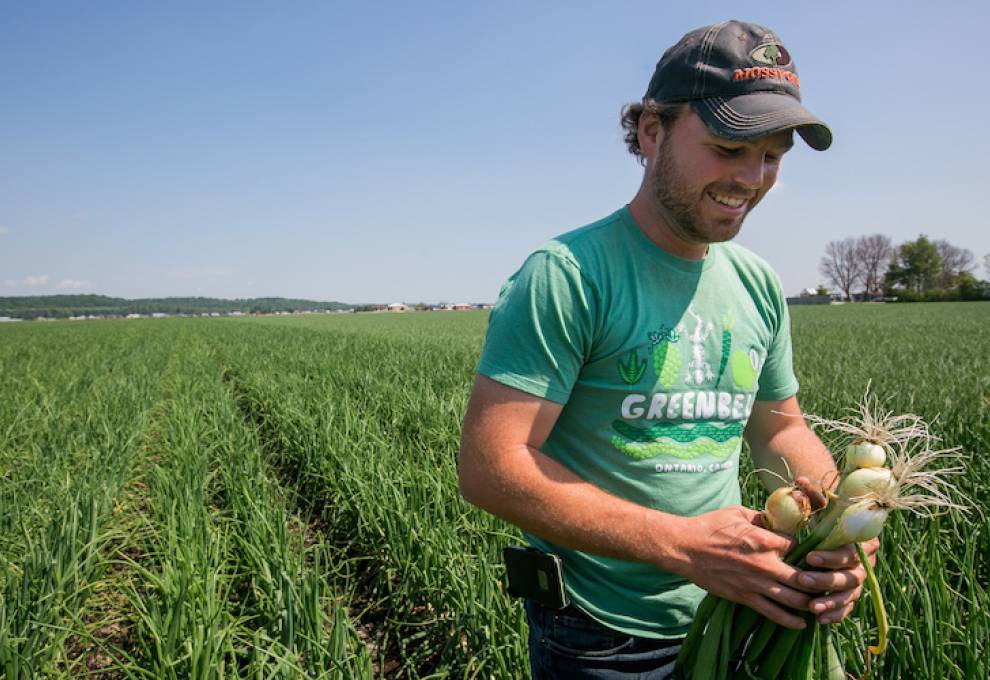
Since the dirty ‘30s, dirt has never been the same.
“Dirt is what is on your hands,” spits out Kyle Horlings, fourth-generation onion and carrot grower, as if he had grit in his mouth.
“This is soil and what’s going on underground is what makes you profitable. It’s like a motor. There are a lot of components and you have to keep it tuned.”
After decades of intensive farming in Ontario’s Holland Marsh, the Horlings family – Kyle and his dad Dave – are getting their soils back in shape. In 2007, they observed that not only were yields slipping, but quality was sliding too. Of their 150 acres near King, Ontario, they would encounter a patchy field where the carrots were short and stubby, even forked. All of these were symptoms of nematode damage and soil-borne diseases such as Pythium.
The effects of “tired” soil? Carrots were no longer marketable from some sections. What was a bad acre one year would become two acres of questionable harvest the next. The harvester was set to dump carrots back on the field, rather than set up a special wash line to sort the mixed quality. This practice was not sustainable.
Despite trying fumigants one year, nothing worked.
A graduate of the University of Guelph Ridgetown Campus, Kyle Horlings had been inspired by one of his lecturers who had extolled the benefits of cover cropping to improve soil health. So he set to researching the latest scientific literature. He came across the USDA publication: Growing cover crops profitably.
Since 2015, Horlings has pulled almost 10 acres of carrots out of production every year to rejuvenate the soil with cover crops. The practice has continued, rotating out of a total of 150 acres of carrots and onions.
The first year, he planted cereal rye after harvesting seed onions in late September. The following May, he plowed it under before seed heads developed. A week later, he planted sorghum sudan grass and sunn hemp. In late August, that crop was chopped down and tillage radishes were planted to cover the land for winter. The following spring, transplant onions were planted.
“I call it a land rest cycle,” says Horlings.
The next year, in a different field with either nematodes or pythium, the land was rested using mustard planted between the rows of rye that had been sprayed with a herbicide. The mustard was allowed to grow to about six feet in height, then chopped and incorporated for a biofumigation effect. A week later, sorghum sudan grass was planted, then chopped in late August. The field was planted to radishes for the winter. Transplant onions were planted in the rejuvenated field the next spring.
“This was a big success,” says Horlings. “There were no weeds. And we harvested a bumper crop of 50 boxes of onions per acre.”
That translates to 1,500 pounds of onions per box.
These results have been followed closely by Dennis Van Dyk, an OMAFRA vegetable crop specialist dedicated to potatoes and root vegetables. He’s been taking soil samples throughout the process and with funding from another project, been able to conduct DNA lab tests to identify all the micro-organisms present in the soil.
“This is next-generation sequencing,”explains Van Dyk. “The process generates gigabytes of data and allows us to identify the thousands of microbes found in the soil. The idea is to see what good and bad microbes are doing and how those communities are shifting with the different cover crops grown.”
It’s too early for those test results, but in the interim Van Dyk is observing that other growers are taking an interest in the long-term sustainability of their soils.
“It’s a commitment to sacrifice a year of profit for long-term benefits,” he says. “With onions being harvested in August/September, there’s time to sow a cover crop such as fall rye to keep the soil in place. This is much more difficult with carrots that come off later and there’s no time to establish a cover.”
That was the case in a snowy November 2019, with many acres of carrots that won’t get harvested until December. Unpredictable weather determines how well a cover cropping strategy can work.
As the calendar shifts towards year’s end, Horlings is still musing about 2020 plans.
“Do we shift cover cropping to land that’s more profitable?” questions Horlings. “I’ll have to go to the drawing board for that.”
One thing he knows for sure.
“This is not just dirt,” he says. “There’s a lot of biology going on there.”

Add new comment